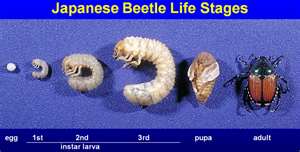Grubs are the larval stage of the Japanese Beetle.
Grubs
- The grub is about 1″ long.
- It has a white body and amber colored head.
- It is often bent in a “C” shape.
- Grubs can take over and destroy a lawn in one season by…
- The grubs themselves eating the grass roots.
- Critters (moles, raccoons, skunks, birds) digging at the lawn to eat the grubs.
- Y0u need to get rid of the grubs to get rid of the critters.
- You need to get rid of the grubs before you can repair the lawn.
Japanese Beetles
- The Japanese beetle is about 1/2″ long.
- It has a metallic green body and bronze wings.
- Japanese beetles feed on the foliage of trees, shrubs, vines and vegetable crops.
- Adults are mostly seen in late spring to early summer.
- Females can lay up to 60 eggs, usually laying a few at a time.
- The eggs will hatch in about two weeks.
- They have a one year life cycle.
Did you know that:
- Adults lay eggs in the ground during the summer.
- As soon as grubs hatch, they begin to feed on the grass roots.
- As cold weather comes, grubs go deeper into the soil and hibernate for the winter.
- As weather gets warmer, they return to the surface soil to feed on grass roots again.
- Grubs mature and pupate in May and June.
- In about 2 weeks the pupae becomes an adult and emerges from the ground.
Here’s a chart of the grub / Japanese beetle life cycle
The ideal time to kill the grub is when they are closest to the surface of the soil and when they are young. This is why we apply preventive grub control in July to early August.
Don’t risk losing your lawn to grubs. Call Sterling Insect & Lawn Control to schedule your Preventive Grub application.
Call (207) 767-555 today to get on the schedule!










